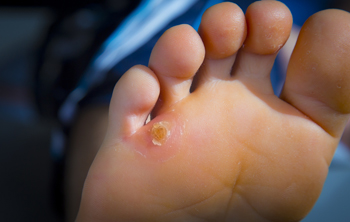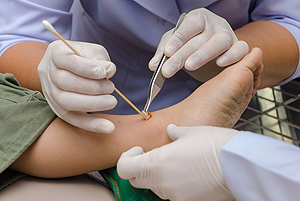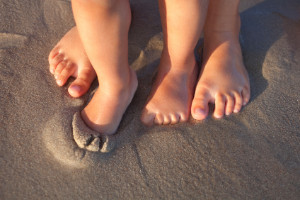Items filtered by date: July 2021
How to Avoid Ingrown Toenails
 Ingrown toenails can be painful, embarrassing, and—at worst—may even become infected, swollen, red, or purulent. You can put yourself more at risk of getting an ingrown toenail if you trim your nails improperly or too short. Your toenails should be cut straight across, but not so short that they grow into the surrounding skin. Ill-fitting shoes, tight socks, and sweaty feet can compromise the skin around your toes and make it easier for your nail to pierce or press into the skin and eventually grow into it. Even stubbing your toe or other injuries can make it more likely for an ingrown toenail to develop. If your ingrown toenail progresses, a podiatrist has a variety of treatments to relieve pain and pressure, and to prevent infection.
Ingrown toenails can be painful, embarrassing, and—at worst—may even become infected, swollen, red, or purulent. You can put yourself more at risk of getting an ingrown toenail if you trim your nails improperly or too short. Your toenails should be cut straight across, but not so short that they grow into the surrounding skin. Ill-fitting shoes, tight socks, and sweaty feet can compromise the skin around your toes and make it easier for your nail to pierce or press into the skin and eventually grow into it. Even stubbing your toe or other injuries can make it more likely for an ingrown toenail to develop. If your ingrown toenail progresses, a podiatrist has a variety of treatments to relieve pain and pressure, and to prevent infection.
Ingrown toenails may initially present themselves as a minor discomfort, but they may progress into an infection in the skin without proper treatment. For more information about ingrown toenails, contact Leonora Fihman, DPM of California. Our doctor can provide the care you need to keep you pain-free and on your feet.
Ingrown Toenails
Ingrown toenails are caused when the corner or side of a toenail grows into the soft flesh surrounding it. They often result in redness, swelling, pain, and in some cases, infection. This condition typically affects the big toe and may recur if it is not treated properly.
Causes
- Improper toenail trimming
- Genetics
- Improper shoe fitting
- Injury from pedicures or nail picking
- Abnormal gait
- Poor hygiene
You are more likely to develop an ingrown toenail if you are obese, have diabetes, arthritis, or have any fungal infection in your nails. Additionally, people who have foot or toe deformities are at a higher risk of developing an ingrown toenail.
Symptoms
Some symptoms of ingrown toenails are redness, swelling, and pain. In rare cases, there may be a yellowish drainage coming from the nail.
Treatment
Ignoring an ingrown toenail can have serious complications. Infections of the nail border can progress to a deeper soft-tissue infection, which can then turn into a bone infection. You should always speak with your podiatrist if you suspect you have an ingrown toenail, especially if you have diabetes or poor circulation.
If you have any questions, please feel free to contact our offices located in Encino and Brentwood, Los Angeles, CA . We offer the newest diagnostic and treatment technologies for all your foot care needs.
Is It a Wart or a Corn?
Corns and warts are two similar looking skin growths that can crop up on the feet. A wart is a fleshy growth on the foot caused by a human papillomavirus (HPV) infection. The warts tend to have a rough, grainy texture, with small black dots appearing in the center. Warts can grow by themselves or in clusters. Corns, on the other hand, are thick, hard bumps that develop on the skin due to repetitive friction. Corns usually grow on the tops and sides of the feet, particularly on top of the toes, or in between the toes. They may be surrounded by dry, flaky skin. Both corns and warts can be painful, especially if pressure is applied to them while standing or walking. Whether you have warts or corns, don’t hesitate to schedule an appointment with a podiatrist, who can diagnose your condition and prescribe the right treatment for you.
If you have any concerns regarding your feet and ankles, contact Leonora Fihman, DPM of California. Our doctor will treat your foot and ankle needs.
Corns: What Are They? and How Do You Get Rid of Them?
Corns can be described as areas of the skin that have thickened to the point of becoming painful or irritating. They are often layers and layers of the skin that have become dry and rough, and are normally smaller than calluses.
Ways to Prevent Corns
There are many ways to get rid of painful corns such as wearing:
- Well-fitting socks
- Comfortable shoes that are not tight around your foot
- Shoes that offer support
Treating Corns
Treatment of corns involves removing the dead skin that has built up in the specific area of the foot. Consult with Our doctor to determine the best treatment option for your case of corns.
If you have any questions please feel free to contact our offices located in Encino and Brentwood, Los Angeles, CA . We offer the newest diagnostic and treatment technologies for all your foot and ankle needs.
The Wagner Diabetic Foot Ulcer Classification System
If you suffer from diabetes, you may be familiar with the increased risk of developing poorly healing wounds on your feet. Small cuts, sores, or scrapes can go unnoticed due to neuropathy or nerve damage, and heal slowly because of poor circulation. These issues can make wounds grow larger and become infected, turning into diabetic foot ulcers (DFUs). There are various classification systems for describing the general characteristics of these wounds. Doctors who use the Wagner system classify DFUs by their severity, in a graded system ranging from 0 to 5. A Grade 0 ulcer means that the skin is intact. Grade 1 signifies a superficial ulcer on the outer layers of skin. Grade 2 is a deep ulcer. Grade 3 is an ulcer with bone involvement. Grade 4 means that there is gangrene or dead tissue in the front of the foot, while Grade 5 means that the gangrene has spread to the entire foot. If you notice any wounds on your feet, please schedule an appointment with a podiatrist who can treat wounds and help you manage your condition.
Wound care is an important part in dealing with diabetes. If you have diabetes and a foot wound or would like more information about wound care for diabetics, consult with Leonora Fihman, DPM from California. Our doctor will assess your condition and provide you with quality foot and ankle treatment.
What Is Wound Care?
Wound care is the practice of taking proper care of a wound. This can range from the smallest to the largest of wounds. While everyone can benefit from proper wound care, it is much more important for diabetics. Diabetics often suffer from poor blood circulation which causes wounds to heal much slower than they would in a non-diabetic.
What Is the Importance of Wound Care?
While it may not seem apparent with small ulcers on the foot, for diabetics, any size ulcer can become infected. Diabetics often also suffer from neuropathy, or nerve loss. This means they might not even feel when they have an ulcer on their foot. If the wound becomes severely infected, amputation may be necessary. Therefore, it is of the upmost importance to properly care for any and all foot wounds.
How to Care for Wounds
The best way to care for foot wounds is to prevent them. For diabetics, this means daily inspections of the feet for any signs of abnormalities or ulcers. It is also recommended to see a podiatrist several times a year for a foot inspection. If you do have an ulcer, run the wound under water to clear dirt from the wound; then apply antibiotic ointment to the wound and cover with a bandage. Bandages should be changed daily and keeping pressure off the wound is smart. It is advised to see a podiatrist, who can keep an eye on it.
If you have any questions, please feel free to contact our offices located in Encino and Brentwood, Los Angeles, CA . We offer the newest diagnostic and treatment technologies for all your foot care needs.
How Obesity Affects a Child’s Feet
The arch of the foot is primarily responsible for absorbing and dispersing reaction forces that feet encounter during normal activities. When ligaments which support the arch are subject to prolonged, excessive loading from obesity, they can become overly stretched, damaged, and painful. Children who are obese may be more prone to foot pain and flat feet due to increased levels of pressure put on the soles of the feet. This, in turn, may restrict their ability to participate in physical activity. If your child is obese and is experiencing pain in their feet, it is suggested that you schedule an appointment with a podiatrist who may prescribe custom orthotics to help improve foot alignment, decrease pain and improve overall mobility.
The health of a child’s feet is vital to their overall well-being. If you have any questions regarding foot health, contact Leonora Fihman, DPM of California. Our doctor can provide the care you need to keep you pain-free and on your feet.
Tips for Keeping Children's Feet Healthy
- Make sure their shoes fit properly
- Look for any signs of in-toeing or out-toeing
- Check to see if they have Clubfoot (condition that affects your child’s foot and ankle, twisting the heel and toes inward) which is one of the most common nonmajor birth defects.
- Lightly cover your baby’s feet (Tight covers may keep your baby from moving their feet freely, and could prevent normal development)
- Allow your toddler to go shoeless (Shoes can be restricting for a young child’s foot)
- Cut toenails straight across to avoid ingrown toenails
- Keep your child’s foot clean and dry
- Cover cuts and scrapes. Wash any scratches with soap and water and cover them with a bandage until they’ve healed.
If you have any questions, please feel free to contact our offices located in Encino and Brentwood, Los Angeles, CA . We offer the newest diagnostic and treatment technologies for all your foot care needs.




